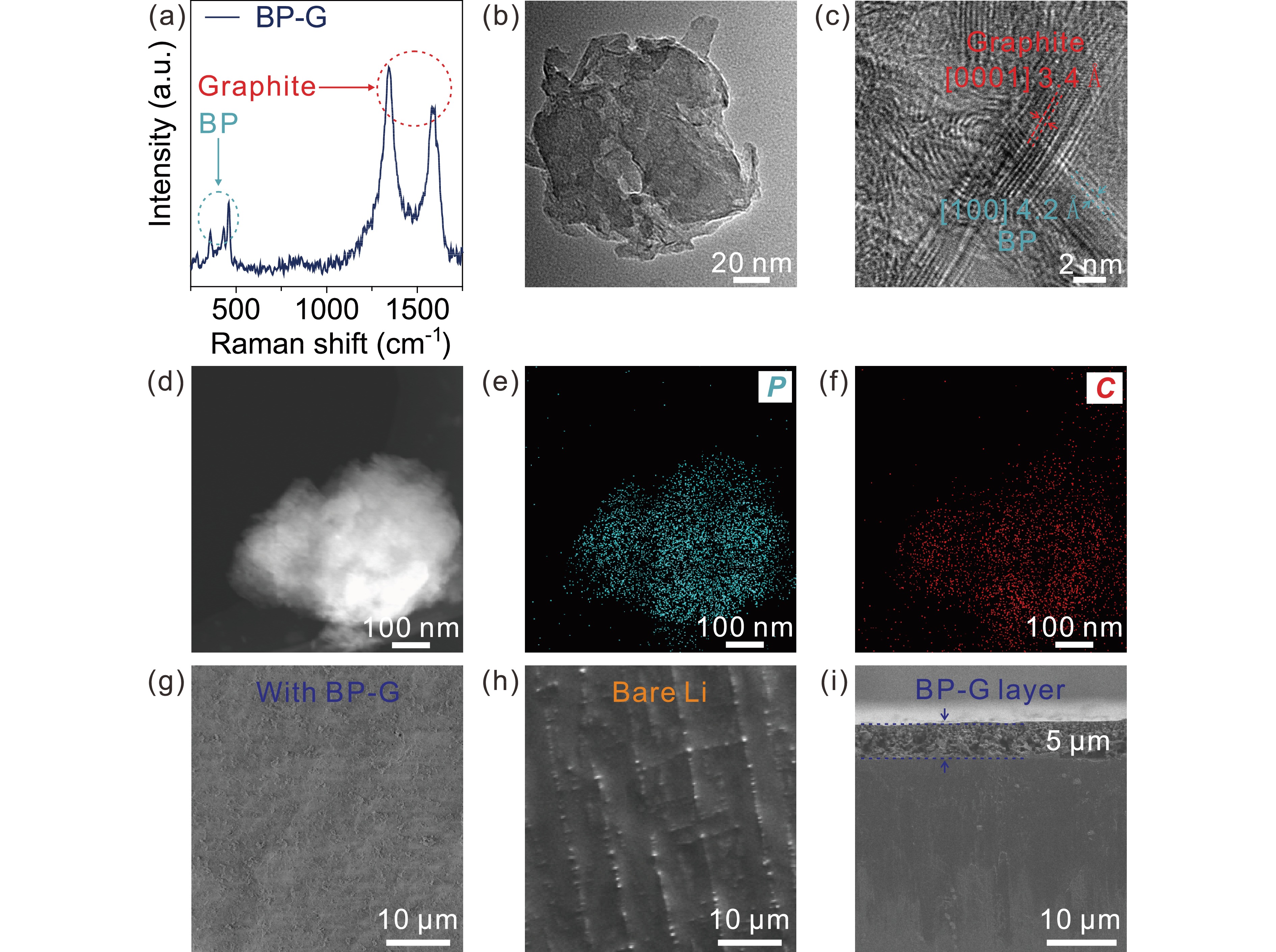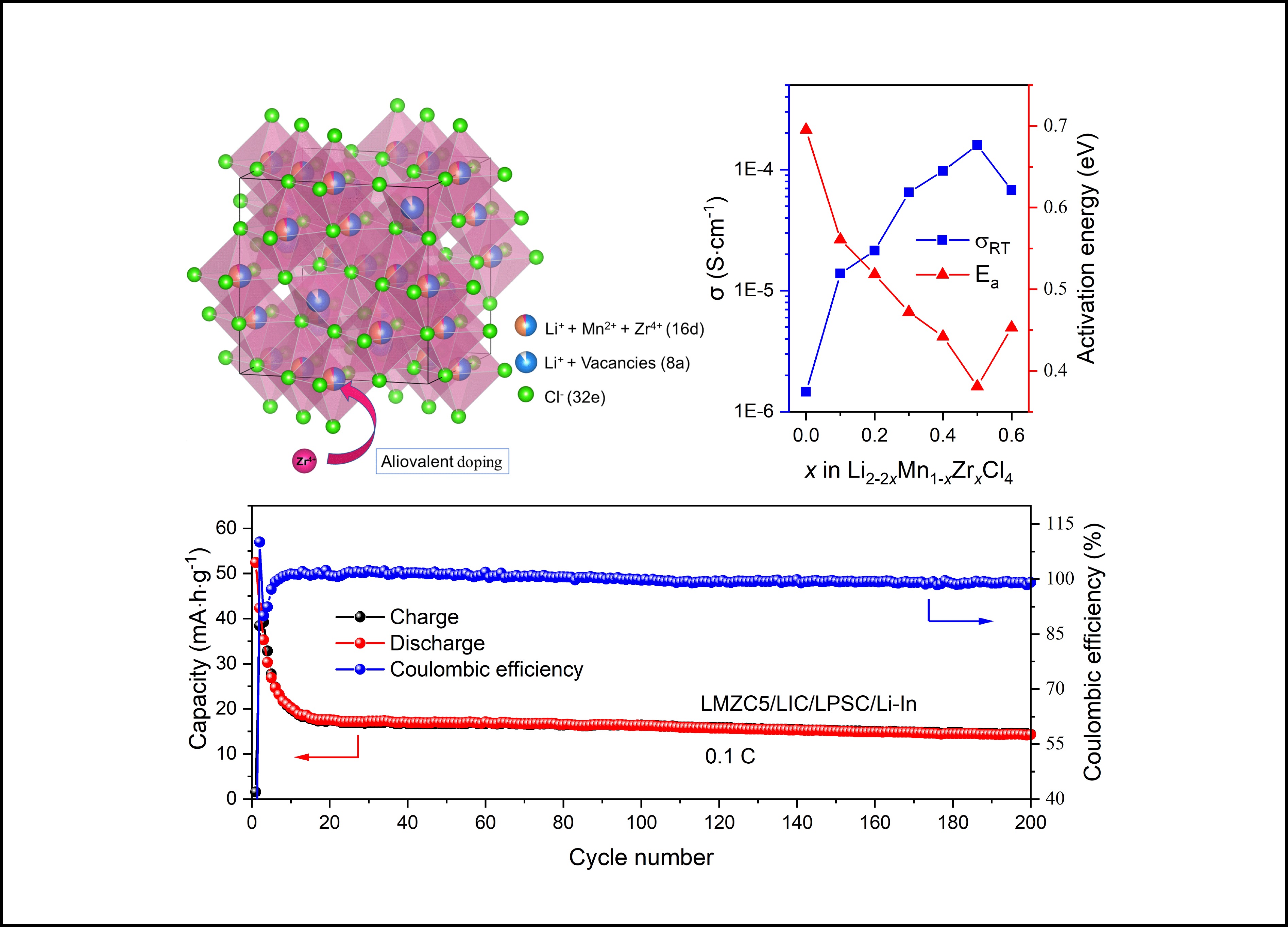
ISSN 0253-2778
CN 34-1054/N
All-solid-state Li batteries (ASSLBs) are now considered to be next-generation energy storage devices due to their advantages in safety and energy density. With liquid electrolytes replaced by solid electrolytes, novel cathode active materials (CAMs) with different characteristics are needed. The solid-solid contact in ASSLBs requires CAMs to have good deformability. In addition, higher ionic conductivity is also essential to reduce the mass of the Li-ion conductive agent, thus accessing a higher overall capacity. Herein, we report a spinel-type chloride cathode Li2−2xMn1−xZrxCl4, which has good deformability and high ionic conductivity (up to 0.16 mS∙cm−1 at 25 °C). The ASSLB using the optimal composition of LiMn0.5Zr0.5Cl4 as the cathode exhibits promising cycling stability for 200 cycles at room temperature.

Zr4+-doped spinel-type chloride Li2-2xMn1-xZrxCl4 exhibits high ionic conductivity and promising cycling stability.
| [1] |
Janek J, Zeier W G. A solid future for battery development. Nature Energy, 2016, 1: 16141. DOI: 10.1038/nenergy.2016.141
|
| [2] |
Li J, Ma C, Chi M, et al. Solid electrolyte: The key for high-voltage lithium batteries. Advanced Energy Materials, 2015, 5: 1401408. DOI: 10.1002/aenm.201401408
|
| [3] |
Xia S, Wu X, Zhang Z, et al. Practical challenges and future perspectives of all-solid-state lithium-metal batteries. Chem, 2019, 5: 753–785. DOI: 10.1016/j.chempr.2018.11.013
|
| [4] |
Albertus P, Anandan V, Ban C, et al. Challenges for and pathways toward Li-metal-based all-solid-state batteries. ACS Energy Letters, 2021, 6: 1399–1404. DOI: 10.1021/acsenergylett.1c00445
|
| [5] |
Gao X, Liu B, Hu B, et al. Solid-state lithium battery cathodes operating at low pressures. Joule, 2022, 6: 636–646. DOI: 10.1016/j.joule.2022.02.008
|
| [6] |
Tanibata N, Kato M, Takimoto S, et al. High formability and fast lithium diffusivity in metastable spinel chloride for rechargeable all-solid-state lithium-ion batteries. Advanced Energy and Sustainability Research, 2020, 1: 2000025. DOI: 10.1002/aesr.202000025
|
| [7] |
Zhao Q, Stalin S, Zhao C Z, et al. Designing solid-state electrolytes for safe, energy-dense batteries. Nature Reviews Materials, 2020, 5: 229–252. DOI: 10.1038/s41578-019-0165-5
|
| [8] |
Nitta N, Wu F, Lee J T, et al. Li-ion battery materials: present and future. Materials Today, 2015, 18: 252–264. DOI: 10.1016/j.mattod.2014.10.040
|
| [9] |
Ellis B L, Lee K T, Nazar L F. Positive electrode materials for Li-ion and Li-batteries. Chemistry of Materials, 2010, 22: 691–714. DOI: 10.1021/cm902696j
|
| [10] |
Cros C, Hanebali L, Latie´ L, et al. Structure, ionic motion and conductivity in some solid-solutions of the LiCl-MCl2 systems (M=Mg, V, Mn). Solid State Ionics, 1983, 9-10: 139–147. DOI: 10.1016/0167-2738(83)90223-0
|
| [11] |
Kanno R, Takeda Y, Takada K, et al. Ionic conductivity and phase transition of the spinel system Li2−2 xM1+ xCl4 (M=Mg, Mn, Cd). Journal of The Electrochemical Society, 1984, 131: 469–474. DOI: 10.1149/1.2115611
|
| [12] |
Han F, Zhu Y, He X, et al. Electrochemical stability of Li10GeP2S12 and Li7La3Zr2O12 solid electrolytes. Advanced Energy Materials, 2016, 6: 1501590. DOI: 10.1002/aenm.201501590
|
| [13] |
van Loon C J J, de Jong J. Some chlorides with the inverse spinel structure. Acta Crystallographica Section B:Structural Science, Crystal Engineering and Materials, 1975, 31: 2549–2550. DOI: 10.1107/S0567740875008114
|
| [14] |
Li X N, Liang J W, Luo J, et al. Air-stable Li3InCl6 electrolyte with high voltage compatibility for all-solid-state batteries. Energy & Environmental Science, 2019, 12: 2665–2671. DOI: 10.1039/c9ee02311a
|
| [15] |
Liang J, Li X, Wang S, et al. Site-occupation-tuned superionic Li xScCl3+ x halide solid electrolytes for all-solid-state batteries. Journal of the American Chemical Society, 2020, 142: 7012–7022. DOI: 10.1021/jacs.0c00134
|
| [16] |
Wang K, Ren Q, Gu Z, et al. A cost-effective and humidity-tolerant chloride solid electrolyte for lithium batteries. Nature Communications, 2021, 12: 4410. DOI: 10.1038/s41467-021-24697-2
|
| [17] |
Kwak H, Han D, Lyoo J, et al. New cost-effective halide solid electrolytes for all-solid-state batteries: Mechanochemically prepared Fe3+-substituted Li2ZrCl6. Advanced Energy Materials, 2021, 11: 2003190. DOI: 10.1002/aenm.202003190
|
| [18] |
Asano T, Sakai A, Ouchi S, et al. Solid halide electrolytes with high lithium-ion conductivity for application in 4 V class bulk-type all-solid-state batteries. Advanced Materials, 2018, 30: 1803075. DOI: 10.1002/adma.201803075
|
| [19] |
Zhu Y Z, He X F, Mo Y F. Origin of outstanding stability in the lithium solid electrolyte materials: insights from thermodynamic analyses based on first-principles calculations. ACS Applied Materials & Interfaces, 2015, 7: 23685–23693. DOI: 10.1021/acsami.5b07517
|
| [20] |
Ong S P, Wang L, Kang B, et al. Li−Fe−P−O2 phase diagram from first principles calculations. Chemistry of Materials, 2008, 20: 1798–1807. DOI: 10.1021/cm702327g
|
| [21] |
Mo Y, Ong S P, Ceder G. First principles study of the Li10GeP2S12 lithium super ionic conductor material. Chemistry of Materials, 2012, 24: 15–17. DOI: 10.1021/cm203303y
|
| [22] |
Jain A, Ong S P, Hautier G, et al. Commentary: The Materials Project: A materials genome approach to accelerating materials innovation. APL Materials, 2013, 1: 011002. DOI: 10.1063/1.4812323
|